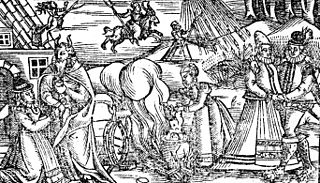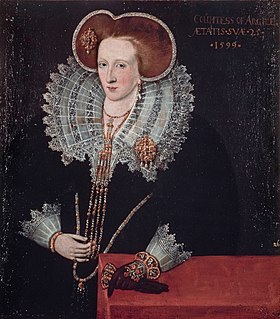Related Research Articles

Isobel Gowdie was a Scottish woman who confessed to witchcraft at Auldearn near Nairn during 1662. Scant information is available about her age or life and, although she was probably executed in line with the usual practice, it is uncertain whether this was the case or if she was allowed to return to the obscurity of her former life as a cottar’s wife. Her detailed testimony, apparently achieved without the use of violent torture, provides one of the most comprehensive insights into European witchcraft folklore at the end of the era of witch-hunts.

Edward Bruce, 1st Lord Kinloss PC was a Scottish lawyer and judge.

Scotland in the early modern period refers, for the purposes of this article, to Scotland between the death of James IV in 1513 and the end of the Jacobite risings in the mid-eighteenth century. It roughly corresponds to the early modern period in Europe, beginning with the Renaissance and Reformation and ending with the start of the Enlightenment and Industrial Revolution.
The Octavians were a financial commission of eight in the government of Scotland first appointed by James VI on 9 January 1596.

The Ainslie Tavern Bond was a document signed on about 20 April 1567 by a number of Scottish bishops and nobles. The bond approved the Earl of Bothwell's acquittal on 12 April of implication in the murder of Lord Darnley, recommended him as an appropriate husband for Mary, Queen of Scots, and pledged to assist in defending such a marriage.

Scottish society in the early modern era encompasses the social structure and relations that existed in Scotland between the early sixteenth century and the mid-eighteenth century. It roughly corresponds to the early modern era in Europe, beginning with the Renaissance and Reformation and ending with the last Jacobite risings and the beginnings of the industrial revolution.

In early modern Scotland, inbetween the early 16th century and the mid-18th century, judicial proceedings concerned with the crimes of witchcraft took place as part of a series of witch trials in Early Modern Europe. In the late middle age there were a handful of prosecutions for harm done through witchcraft, but the passing of the Witchcraft Act 1563 made witchcraft, or consulting with witches, capital crimes. The first major issue of trials under the new act were the North Berwick witch trials, beginning in 1590, in which King James VI played a major part as "victim" and investigator. He became interested in witchcraft and published a defence of witch-hunting in the Daemonologie in 1597, but he appears to have become increasingly sceptical and eventually took steps to limit prosecutions.

Women in early modern Scotland, between the Renaissance of the early sixteenth century and the beginnings of industrialisation in the mid-eighteenth century, were part of a patriarchal society, though the enforcement of this social order was not absolute in all aspects. Women retained their family surnames at marriage and did not join their husband's kin groups. In higher social ranks, marriages were often political in nature and the subject of complex negotiations in which women as matchmakers or mothers could play a major part. Women were a major part of the workforce, with many unmarried women acting as farm servants and married women playing a part in all the major agricultural tasks, particularly during harvest. Widows could be found keeping schools, brewing ale and trading, but many at the bottom of society lived a marginal existence.

The great Scottish witch hunt of 1649–50 was a series of witch trials in Scotland. It is one of five major hunts identified in early modern Scotland and it probably saw the most executions in a single year.

The 1594 trial of alleged witch Allison Balfour or Margaret Balfour is one of the most frequently cited Scottish witchcraft cases. Balfour lived in the Orkney Islands of Scotland in the area of Stenness. At that time in Scotland, the Scottish Witchcraft Act 1563 had made a conviction for witchcraft punishable by death.

Margaret Aitken, known as the Great Witch of Balwearie, was an important figure in the great Scottish witchcraft panic of 1597 as her actions effectively led to an end of that series of witch trials. After being accused of witchcraft Aitken confessed but then identified hundreds of women as other witches to save her own life. She was exposed as a fraud a few months later and was burnt at the stake.

The Bute witches were six Scottish women accused of witchcraft and interrogated in the parish of Rothesay on Bute during the Great Scottish Witch Hunt of 1661–62. The Privy Council granted a Commission of Justiciary for a local trial to be held and four of the women – believed by historians to be Margaret McLevin, Margaret McWilliam, Janet Morrison and Isobell McNicoll – were executed in 1662; a fifth may have died while incarcerated. One woman, Jonet NcNicoll, escaped from prison before she could be executed but when she returned to the island in 1673 the sentence was implemented.
Thomas Foulis was a Scottish goldsmith, mine entrepreneur, and royal financier.
Alison Pearson was executed for witchcraft. On being tried in 1588, she confessed to visions of a fairy court.
George Young was a Scottish churchman, courtier, member of the Privy Council of Scotland, diplomat, and secretary depute.
Maureen M. Meikle is an academic historian.

Queen Elizabeth I of England paid a subsidy to King James VI of Scotland from 1586 to 1602. This enabled her to influence James by delaying or deferring payments to his diplomats in London. Records survive of the yearly amounts, and details of the expenditure in some years. A large proportion of the money was spent on the royal wardrobe of James and Anne of Denmark. Some royal expenses were met by Anne of Denmark's dowry, which was known as the "tocher".
Alexander Hay of Easter Kennet was a Scottish lawyer and politician.
Violet Mar was a Scottish woman accused of plotting the death of Regent Morton by witchcraft.

Anne of Denmark (1574-1619) was the wife of King James VI and I, and as such Queen of Scotland from their marriage by proxy on 20 August 1589 and Queen of England and Ireland from 24 March 1603 until her death in 1619. When Anne intended to sail to Scotland in 1589 her ship was delayed by adverse weather. Contemporary superstition blamed the delays to her voyage and other misfortunes on "contrary winds" summoned by witchcraft. There were witchcraft trials in Denmark and in Scotland. The King's kinsman, Francis Stewart, 5th Earl of Bothwell came into suspicion. The Chancellor of Scotland John Maitland of Thirlestane was thought to be Bothwell's enemy, Maitland was lampooned in a poem Rob Stene's Dream, and Anne of Denmark made Maitland her enemy. Historians continue to investigate these significant events.
References
- ↑ "Featured Author Julian Goodare".
{{cite web}}: CS1 maint: url-status (link) - ↑ "About our staff".
{{cite web}}: CS1 maint: url-status (link) - 1 2 "Calls for memorial to Scotland's tortured and executed witches". TheGuardian.com . 29 October 2019.
{{cite web}}: CS1 maint: url-status (link) - ↑ Julian Goodare, 'The Octavians', Miles Kerr-Peterson & Steven J. Reid, James VI and Noble Power in Scotland, 1578-1603 (Routledge, 2017), pp. 176-193.
- ↑ Julian Goodare, 'James VI's English Subsidy', in Julian Goodare & Michael Lynch, The Reign of James VI (East Linton, Tuckwell, 2000), p. 113.
- ↑ Julian Goodare, 'The Ainslie Bond', Kings, Lords and Men in Scotland and Britain, 1300-1625 (Edinburgh, 2014), pp. 15, 301-319.